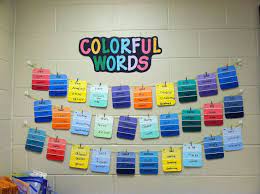Introduction:
A word wall is a fantastic tool to enhance students’ literacy skills. Displaying words on a classroom wall provides a visual aid for students, encouraging them to expand their vocabulary and develop their reading and writing abilities. Here are 28 helpful word wall ideas to consider when setting up your classroom.
1. Alphabetical Order: Arrange words alphabetically to help students familiarize themselves with the arrangement of letters.
2. Color-Coded Words: Assign different colors to various word categories, such as nouns, verbs, or adjectives.
3. Thematic Sections: Organize words by themes or topics relevant to your curriculum.
4. Word Families: Group words with similar patterns or endings together.
5. Parts of Speech: Clearly label each word according to its part of speech.
6. Word of the Day: Select a new word daily and highlight it on your word wall, encouraging students to use it throughout that day.
7. Idiom Corner: Create a special section for idiomatic expressions and their meanings.
8. Tiered Vocabulary: Organize words based on their complexity, allowing students to progress from simpler words to more advanced vocabulary.
9. Sign Language: Incorporate sign language images next to each word for added learning opportunities.
10. Picture Clues: Provide images or symbols for each word as a visual reminder of its meaning.
11. QR Codes: Attach QR codes linked to informative videos related to the displayed words.
12. Famous Quotes: Post famous quotes using selected vocabulary words as examples in context.
13. Interactive Games and Puzzles: Include crossword puzzles, word searches, or other interactive elements on your word wall for students to explore.
14. Bulletin Board Borders: Use decorative borders around your word wall sections for added visual appeal.
15. Chalkboard Wall Paint: Paint your wall with chalkboard paint so you can easily write new words directly onto the wall.
16. Acrostic Wall: Use large letter stickers to create a word wall shaped like an acrostic poem.
17. Seasonal Display: Rotate your word wall with vocabulary relevant to each season.
18. Word Progression: Start with simpler words, and gradually add more advanced vocabulary as students progress.
19. Spelling Patterns: Highlight common spelling patterns, such as homophones or silent letters.
20. Synonyms and Antonyms: Pair words together with their synonyms or antonyms for added vocabulary reinforcement.
21. Student-Generated Words: Allow students to suggest words to be included on the word wall.
22. Reader Recommendations: Encourage students to recommend words they discover in their independent reading material.
23. Bilingual Display: Include translations for each word in multiple languages spoken by your students.
24. Classroom Favorites: Add commonly used words from class discussions and lessons.
25. Magnetic Wall: Use magnetic paint or a magnetic board for easily rearranging words on your word wall.
26. Velcro Wall: Attach Velcro strips to allow for easy adjustments and quick changes to the display.
27. Word Ladder: Create a word ladder showcasing new vocabulary words that build upon one another.
28. Online Collaborative Word Wall: Utilize digital platforms, such as Padlet or Google Slides, where students can contribute and interact with the word wall virtually.
Conclusion:
A word wall is an essential tool for building literacy skills within your classroom, but its impact is only as strong as its design and content. With these 28 helpful ideas in mind, you can create a dynamic, engaging word wall that effectively supports your students’ growth and development in language arts.





